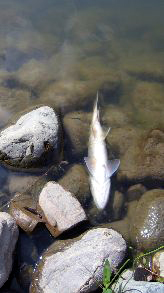Winter Under the Ice: The Dreaded Fish Kill
What happens under the ice?

The winter is stretching and snow accumulates on the ice on our pond… it appears as if the watery life fell asleep while waiting for the beautiful days of spring. What happens under the ice? One imagines peace and calm and yet many ponds can be undergoing tragic changes deep beneath the surface. You may well ask how?
My neighbour told me the other day “I’ve never had problems with my pond but last year I had poachers who completely emptied the fish from my pond!” I asked him if he had any evidence that people were fishing from his lake and he said: “Certainly! Last spring, I took out my rod and reel like I had for ten years and nothing! Not a single fish! I had just stocked the pond with 200 trout! Someone must have come and fished them all out!”
 He wasn’t prepared for me to offer another, more plausible theory, on where his trout had gone. I explained to him that his losing his fish was likely the result of natural phenomenon. It is what is often called “fish kills” which result in oxygen deficiency. It is a rather simple concept but is the result of a number of environmental factors, but the fact remains these “fish kills” are entirely preventable.
He wasn’t prepared for me to offer another, more plausible theory, on where his trout had gone. I explained to him that his losing his fish was likely the result of natural phenomenon. It is what is often called “fish kills” which result in oxygen deficiency. It is a rather simple concept but is the result of a number of environmental factors, but the fact remains these “fish kills” are entirely preventable.
All ponds undergo aging and this natural phenomenon is called eutrophication which is another way of saying that the pond has become over-productive in algae and plants with the passing of years and also that its average depth is decreasing because of the accumulation of organic sludge at the bottom. Briefly speaking, the lake is closing in on itself. Naturally, there are innumerable bacteria living at the bottom of your pond that literally eat and recycle the organic sludge, turning into bio-mass which in part becomes fish food.
These incredibly important little creatures need oxygen to survive and as oxygen levels decrease so does the number and effectiveness of these bacteria. When oxygen levels reach critical stages the organic sludge builds up faster than it can be eaten by the friendly bacteria and if the oxygen is not replenished their ability to consume bottom muck is hampered.
In summer, the aquatic plants in your pond produce oxygen during the day during photo-synthesis but when winter comes and the plants are covered in ice and die their production of oxygen stops completely. It is as if the pond must hold its breath throughout the winter waiting to take a breath again in the spring. If the oxygen levels at the onset of winter are not high enough then by February and March the outlook for organisms requiring oxygen is not good. This is one reason I recommend aerating your pond all year round.
All that lives in the lake breathes. As with everything, when demand exceeds supply there is an imbalance and for an aquatic ecosystem this can be catastrophic. The fish will suffocate, the malignant anaerobic bacteria (which live without oxygen) will release toxic substances… it is the quiet catastrophe. The fish die asphyxiated. The anaerobic bacteria (without oxygen) then begin to release harmful, even toxic, substances. If you take a handful of material from the bottom of your pond and it smells like rotten eggs then your pond is in a state of eutrophication.
A simple oil less compressor attached to a system of diffuser discs or bubble tubing will act as a deicer system to reverse the ponds state of eutrophication, re-creating a healthy ecosystem making it hospitable for fish. Your pond can contain as many as three times the number of fish after an aerator is added. Once an aerator is in place you will find that year after year you have less muck and clearer water. There is no magic involved, just an initial investment and some minimal maintenance.